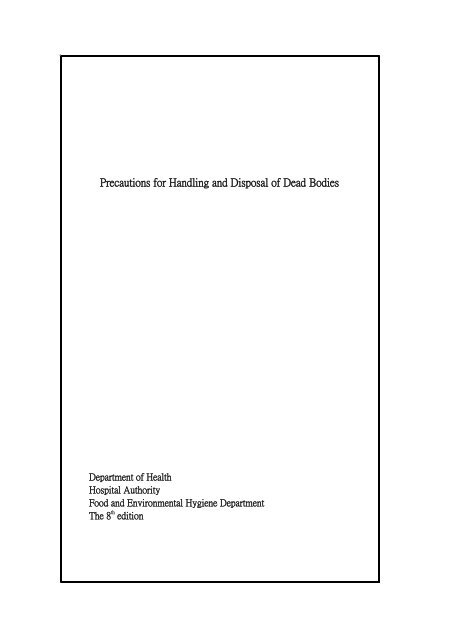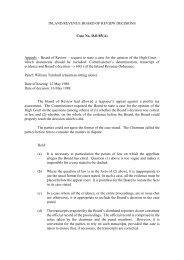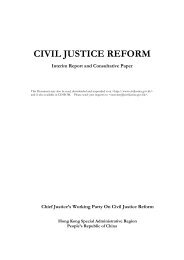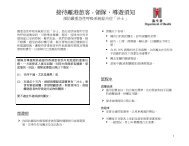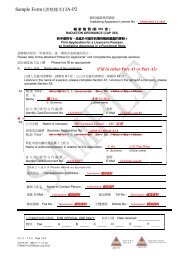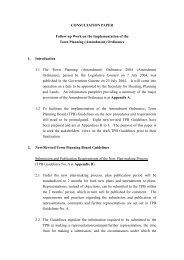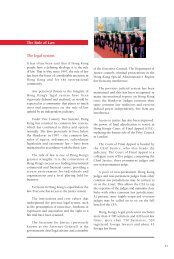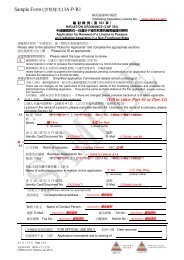Precautions for Handling and Disposal of Dead Bodies (Published ...
Precautions for Handling and Disposal of Dead Bodies (Published ...
Precautions for Handling and Disposal of Dead Bodies (Published ...
You also want an ePaper? Increase the reach of your titles
YUMPU automatically turns print PDFs into web optimized ePapers that Google loves.
<strong>Precautions</strong> <strong>for</strong> <strong>H<strong>and</strong>ling</strong> <strong>and</strong> <strong>Disposal</strong> <strong>of</strong> <strong>Dead</strong> <strong>Bodies</strong><br />
Department <strong>of</strong> Health<br />
Hospital Authority<br />
Food <strong>and</strong> Environmental Hygiene Department<br />
The 8 th edition
This set <strong>of</strong> guidelines is prepared by Infection Control Branch,<br />
Centre <strong>for</strong> Health Protection, Department <strong>of</strong> Health.<br />
Address: Infection Control Branch, G/F Centre <strong>for</strong> Health Protection,<br />
147C, Argyle Street, Kowloon.<br />
If you have any comment or enquiry, please kindly contact the<br />
Secretary <strong>of</strong> Work Group <strong>for</strong> “<strong>Precautions</strong> <strong>for</strong> <strong>H<strong>and</strong>ling</strong> <strong>and</strong><br />
<strong>Disposal</strong> <strong>of</strong> <strong>Dead</strong> <strong>Bodies</strong>”.<br />
December 1994 (1st edition)<br />
May 1997 (2nd edition)<br />
November 1999 (3rd edition)<br />
January 2002 (4th edition)<br />
October 2005 (5th edition)<br />
June 2008 (6th edition)<br />
April 2009 (7th edition)<br />
May 2010 (8th edition)<br />
1
Table <strong>of</strong> Contents<br />
Table <strong>of</strong> Contents 2<br />
Introduction 3<br />
Categorization <strong>of</strong> <strong>Dead</strong> <strong>Bodies</strong> 4<br />
General Recommendations <strong>for</strong> All Related Persons<br />
A. Vaccination<br />
5<br />
B. Personal protective equipment <strong>and</strong> personal hygiene 5<br />
C. Accidental exposure to blood or body fluid<br />
6<br />
D. Clinical waste management<br />
6<br />
E. Disinfection <strong>for</strong> contamination<br />
6<br />
<strong>Precautions</strong> <strong>for</strong> Specific Groups<br />
F. Ward staff<br />
G. Mortuary staff<br />
H. Staff <strong>of</strong> funeral parlours/ Undertakers/ Staff on board<br />
conveyances<br />
I. Staff h<strong>and</strong>ling dead bodies <strong>of</strong> unknown category<br />
J. Relatives <strong>of</strong> the dead<br />
7<br />
10<br />
13<br />
15<br />
16<br />
Appendix 1 :<br />
Samples <strong>of</strong> stickers attached to body bag or dead bodies 17<br />
Appendix 2:<br />
Summary table on precautionary measures <strong>for</strong> h<strong>and</strong>ling <strong>and</strong> 18<br />
disposal <strong>of</strong> dead bodies<br />
2
<strong>Precautions</strong> <strong>for</strong> h<strong>and</strong>ling <strong>and</strong> disposal <strong>of</strong> dead bodies<br />
Introduction<br />
All dead bodies are potentially infectious <strong>and</strong> STANDARD<br />
PRECAUTIONS should be implemented <strong>for</strong> every case. Although most<br />
organisms in the dead body are unlikely to infect healthy persons, some<br />
infectious agents may be transmitted when workers are in close contact with<br />
blood, body fluids <strong>and</strong> tissues <strong>of</strong> dead body <strong>of</strong> person with infectious diseases.<br />
To minimize the risks <strong>of</strong> transmission <strong>of</strong> known <strong>and</strong> also unsuspected infectious<br />
diseases, dead bodies should be h<strong>and</strong>led in such a way that workers’ exposure<br />
to blood, body fluids <strong>and</strong> tissues is reduced. A rational approach should include<br />
staff training <strong>and</strong> education, safe working environment, appropriate work<br />
practices, the use <strong>of</strong> recommended safety devices <strong>and</strong> vaccination against<br />
hepatitis B.<br />
There is a need to maintain the confidentiality <strong>of</strong> a patient’s medical<br />
condition even after his/her death. At the same time, there is obligation to in<strong>for</strong>m<br />
personnel who may be at risk <strong>of</strong> infection through contact with dead bodies so<br />
that appropriate measures may be taken to guard against infection. The discrete<br />
use <strong>of</strong> labels such as “Danger <strong>of</strong> infection” on the dead body is considered<br />
appropriate.<br />
The following outline work practices are recommended when h<strong>and</strong>ling<br />
<strong>and</strong> disposing dead bodies. The objectives <strong>of</strong> drawing up this set <strong>of</strong> guidelines<br />
are: (i) to enable the deceased’s family to obtain funeral services, <strong>and</strong> (ii) to<br />
protect the involved personnel, e.g. workers <strong>and</strong> relatives. Hospitals, public<br />
mortuaries, funeral parlours, undertakers <strong>of</strong> burials <strong>and</strong> staff on board<br />
conveyances are urged to adopt them in light <strong>of</strong> local circumstances <strong>and</strong><br />
requirements. The adopted precautions should be widely disseminated to all<br />
staff involved.<br />
3
Categorization <strong>of</strong> <strong>Dead</strong> Body<br />
Based on the mode <strong>of</strong> transmission <strong>and</strong> risk <strong>of</strong> infection <strong>of</strong> different<br />
diseases, the following categories <strong>of</strong> precautions <strong>for</strong> h<strong>and</strong>ling <strong>and</strong> disposal <strong>of</strong><br />
dead bodies are advised:<br />
Cat. 1:Signified by a BLUE label (Sample attached in Appendix 1).<br />
St<strong>and</strong>ard precautions are recommended.<br />
For all dead bodies other than those with infectious diseases as listed<br />
under Categories 2 & 3.<br />
Cat. 2:Signified by a YELLOW label (Sample attached in Appendix 1).<br />
Additional precautions are recommended.<br />
For dead bodies with known<br />
(a) Human Immunodeficiency Virus infection (HIV)<br />
(b) Hepatitis C<br />
(c) Creutzfeldt-Jacob disease (CJD) without necropsy<br />
(d) Severe Acute Respiratory Syndrome (SARS)<br />
(e) Avian Influenza,<br />
(f) Other infectious diseases as advised by the physician i/c, the infection<br />
control <strong>of</strong>ficer or microbiologist.<br />
Cat. 3:Signified by a RED label (Sample attached in Appendix 1).<br />
Stringent infection precautions are recommended.<br />
For dead bodies with known<br />
(a) Anthrax<br />
(b) Plague<br />
(c) Rabies<br />
(d) Viral haemorrhagic fevers<br />
(e) Creutzfeldt-Jacob disease (CJD) with necropsy, <strong>and</strong><br />
(f) Other infectious diseases as advised by the physician i/c, the<br />
infection control <strong>of</strong>ficer or microbiologist.<br />
The summary table at Appendix 2 provides references to specific<br />
precautionary measures required under respective category.<br />
4
General Recommendations <strong>for</strong> All Related Persons<br />
A. Vaccination<br />
Hepatitis B vaccination is recommended <strong>for</strong> ward staff, mortuary staff,<br />
funeral parlour, undertaker <strong>and</strong> other staff that is likely to come into contact<br />
with dead bodies.<br />
B. Personal Protection Equipment <strong>and</strong> Personal Hygiene<br />
1. Persons who h<strong>and</strong>le dead bodies must wear protective clothing consisting<br />
<strong>of</strong> gown/apron <strong>and</strong> gloves. Protective clothing or uni<strong>for</strong>m must be kept<br />
separate from outdoor clothing.<br />
2. When h<strong>and</strong>ling dead bodies, do not smoke, eat or drink <strong>and</strong> avoid touching<br />
their own mouth, eyes or nose with their h<strong>and</strong>s. Smoking, drinking <strong>and</strong><br />
eating is <strong>for</strong>bidden in the autopsy room, body storage <strong>and</strong> viewing areas.<br />
3. All cuts <strong>and</strong> abrasions should be covered with waterpro<strong>of</strong> b<strong>and</strong>ages or<br />
dressings.<br />
4. Always observe strict personal hygiene especially h<strong>and</strong> hygiene which could<br />
be achieved by good h<strong>and</strong> washing or proper use <strong>of</strong> alcohol-based h<strong>and</strong>rub.<br />
5. Avoid direct contact with blood or body fluids from the dead body.<br />
6. All ef<strong>for</strong>ts should be made to avoid sharps injury, both in the course <strong>of</strong><br />
examination <strong>of</strong> dead body <strong>and</strong> afterwards in dealing with waste disposal <strong>and</strong><br />
decontamination.<br />
7. H<strong>and</strong> hygiene should be per<strong>for</strong>med thoroughly after removing gloves <strong>and</strong><br />
protective clothing.<br />
C. Accidental exposure to blood or body fluids<br />
5
1. In case <strong>of</strong> penetrating injury or mucocutaneous exposure to blood or body<br />
fluids <strong>of</strong> the dead body, the injured or exposed areas should be washed with<br />
copious amount <strong>of</strong> running water. Minor penetrating injuries should be<br />
encouraged to bleed.<br />
2. All incidents <strong>of</strong> exposure to blood or body fluids from the dead body, either<br />
parenteral or mucous membrane exposures, should be reported to<br />
supervisor. The injured person should immediately seek medical advice <strong>for</strong><br />
proper wound care <strong>and</strong> post-exposure management.<br />
D. Clinical Waste Management<br />
Any substance, matter or thing that falls within the definition <strong>of</strong> clinical waste<br />
should be h<strong>and</strong>led <strong>and</strong> disposed <strong>of</strong> properly according to the legal<br />
requirements. Items classified as clinical wastes as specify by the<br />
Environmental Protection Department should also be h<strong>and</strong>led according to<br />
existing hospital/ clinic own procedures. The definition <strong>of</strong> clinical waste <strong>and</strong><br />
its management has been set out in the Waste <strong>Disposal</strong> (Clinical Waste)<br />
(General) Regulation <strong>and</strong> the code <strong>of</strong> Practice <strong>for</strong> the Management <strong>of</strong><br />
Clinical Waste from the Environmental Protection Department.<br />
http://www.epd.gov.hk/epd/clinicalwaste/nonflash/english/downloads/document.html<br />
E. Disinfection <strong>of</strong> contaminated surfaces<br />
All surfaces which may be contaminated with body fluid should be<br />
disinfected with 1 in 49 diluted household bleach* (mixing 1 part <strong>of</strong> 5.25%<br />
bleach with 49 parts <strong>of</strong> water), wipe surface leave <strong>for</strong> 15-30 minutes <strong>and</strong><br />
then rinse with water; or wipe with 70% alcohol <strong>for</strong> metal surface. For<br />
surface contaminated with blood, wipe with 1 in 4 diluted household bleach*<br />
(mixing 1 part <strong>of</strong> 5.25% bleach with 4 parts <strong>of</strong> water), leave <strong>for</strong> 10 minutes<br />
<strong>and</strong> then rinse with water.<br />
* Bleach solution must be freshly prepared.<br />
6
<strong>Precautions</strong> <strong>for</strong> Specific Groups<br />
F. WARD STAFF<br />
F.1 <strong>Precautions</strong> <strong>for</strong> all dead bodies under Category 1<br />
<strong>Dead</strong> body care<br />
1. The body will be classified by attending physician as category 1, 2<br />
or 3. Tags <strong>for</strong> classification <strong>of</strong> categories <strong>of</strong> dead bodies should<br />
be attached to body or body bag.<br />
2. Wound drainage <strong>and</strong> needle puncture holes should be<br />
disinfected with 1 in 4 diluted household bleach (mixing 1 part <strong>of</strong><br />
5.25% bleach with 4 parts <strong>of</strong> water) <strong>and</strong> dressed with<br />
impermeable material.<br />
3. Extreme caution should be exercised when removing intravenous<br />
catheters <strong>and</strong> other devices which are sharp. They should be<br />
disposed into puncture resistant containers.<br />
4. Rectal orifice should be plugged with swabs soaked in 1 in 4<br />
diluted household bleach (mixing 1 part <strong>of</strong> 5.25% bleach with 4<br />
parts <strong>of</strong> water) while gentle suction is recommended <strong>for</strong> other<br />
body orifices such as nostril, to minimize defacing <strong>of</strong> deceased’s<br />
general appearance.<br />
5. The body should be cleaned <strong>and</strong> dried.<br />
6. After identifying <strong>and</strong> attaching to the body the identity label <strong>and</strong><br />
Cat. 1 tag, the body should be wrapped with mortuary sheet<br />
be<strong>for</strong>e being placed on mortuary trolley <strong>and</strong> transported to the<br />
mortuary.<br />
Environmental Control<br />
7. Items classified as clinical wastes should be h<strong>and</strong>led according to<br />
existing hospital/ clinic own procedures (refer General<br />
Recommendation D).<br />
7
8. All used linen should be h<strong>and</strong>led with STANDARD<br />
PRECAUTIONS. Used linen should be h<strong>and</strong>led as little as<br />
possible with minimum agitation to prevent possible contamination<br />
<strong>of</strong> the person h<strong>and</strong>ling the linen <strong>and</strong> prevent the generation <strong>of</strong><br />
potentially contaminated lint aerosols in the areas. Laundry bag<br />
should be securely tied up. Staff should follow the hospital/ clinic<br />
own recommendation on h<strong>and</strong>ling <strong>of</strong> soiled/ infected linen.<br />
9. Used equipment should be autoclaved or decontaminated with<br />
disinfectant solutions in accordance with established disinfectant<br />
policy.<br />
10. All surfaces which may be contaminated should be wiped with<br />
disinfectant solutions in accordance with the recommended<br />
procedures (refer General Recommendation E).<br />
F.2. Additional precautions <strong>for</strong> h<strong>and</strong>ling dead bodies with Infectious<br />
Diseases listed under Category 2 or 3<br />
<strong>Dead</strong> body care<br />
1. To obviate the need <strong>for</strong> the undertaker to h<strong>and</strong>le the body,<br />
following F.1.1 - F.1.5, it is preferable <strong>for</strong> the ward staff to dress<br />
the deceased. Relatives should be alerted <strong>of</strong> the need to prepare<br />
clothing <strong>for</strong> the deceased. If the deceased’s own clothes are not<br />
available, the ward staff should dress the deceased with a<br />
disposable gown or shroud, as a respectful way <strong>of</strong> care to the<br />
deceased.<br />
2. Identify the body <strong>and</strong> attach to the body the appropriate identity<br />
label. The body should be placed in a robust <strong>and</strong> leak pro<strong>of</strong><br />
plastic bag <strong>of</strong> not less than 150 μ m thick, which should be<br />
zippered or closed tightly with tapes <strong>and</strong> b<strong>and</strong>age strips. Pins are<br />
not to be used.<br />
8
3. The outside <strong>of</strong> the plastic bag, if soiled, should be wiped with<br />
disinfectant solutions in accordance with the recommended<br />
procedures (refer General Recommendation E).<br />
4. After identifying <strong>and</strong> attaching to the outside <strong>of</strong> the body bag the<br />
Cat. 2 or Cat. 3 identity tags, the bagged body should be wrapped<br />
with mortuary sheet be<strong>for</strong>e being placed on mortuary trolley <strong>and</strong><br />
transported to the mortuary.<br />
9
G. MORTUARY STAFF<br />
G.1 <strong>Precautions</strong> <strong>for</strong> all dead bodies under Category 1<br />
Training<br />
1. All staff should be trained in the prevention <strong>of</strong> infections. A high<br />
st<strong>and</strong>ard <strong>of</strong> personal hygiene should be adopted.<br />
<strong>Dead</strong> body care<br />
2. All bodies must be identified <strong>and</strong> correctly labeled with identity<br />
labels <strong>and</strong> Cat. 1 tags.<br />
3. <strong>Dead</strong> body which is found soiled with blood or body fluids should<br />
be placed in a disposable plastic bag instead <strong>of</strong> linen.<br />
4. <strong>Bodies</strong> should be stored in cold chambers maintained at approx.<br />
4°C. Storage compartments should be easily accessible <strong>for</strong> both<br />
regular cleaning <strong>and</strong> maintenance.<br />
5. Since each <strong>and</strong> every dead body brought to autopsy is a potential<br />
source <strong>of</strong> infection, at all times, pathologists <strong>and</strong> other support<br />
staff should observe STANDARD PRECAUTIONS in the<br />
per<strong>for</strong>mance <strong>of</strong> any autopsy.<br />
Environmental Control<br />
6. The mortuary must at all times be kept clean <strong>and</strong> properly<br />
ventilated. Lighting must be adequate. Surfaces <strong>and</strong> instruments<br />
should be made <strong>of</strong> materials which could be easily disinfected<br />
<strong>and</strong> maintained.<br />
7. Items classified as clinical wastes should be h<strong>and</strong>led according to<br />
existing hospital/ clinic own procedures (refer General<br />
Recommendation D).<br />
8. All used linen should be h<strong>and</strong>led with STANDARD<br />
PRECAUTIONS. Used linen should be h<strong>and</strong>led as little as<br />
possible with minimum agitation to prevent possible<br />
contamination <strong>of</strong> the person h<strong>and</strong>ling the linen <strong>and</strong> prevent the<br />
generation <strong>of</strong> potentially contaminated lint aerosols in the areas.<br />
10
Laundry bag should be securely tied up. Staff should follow the<br />
hospital/ clinic own recommendation on h<strong>and</strong>ling <strong>of</strong> soiled/<br />
infected linen.<br />
9. Environmental surfaces, instruments <strong>and</strong> transport trolleys should<br />
be decontaminated in accordance with General Recommendation<br />
E.<br />
G.2 Additional precautions <strong>for</strong> h<strong>and</strong>ling dead bodies with infectious<br />
diseases listed under Category 2 or 3<br />
In addition to precautions as listed in G.1 above, the following<br />
additional precautions should also be observed:<br />
<strong>Dead</strong> body care<br />
1. Autopsies on bodies which have died with infectious diseases as<br />
listed under category 2 or 3 expose staff to unwarranted risk <strong>and</strong><br />
should generally not be per<strong>for</strong>med. However, if autopsy is to be<br />
carried out because <strong>of</strong> special reasons, the following practices<br />
should be adopted:<br />
i) It should be per<strong>for</strong>med by a trained pathologist using<br />
recommended barrier techniques <strong>and</strong> procedures to reduce<br />
the risk <strong>of</strong> infection.<br />
ii) The number <strong>of</strong> people allowed in the autopsy room should be<br />
limited to those directly involved in the operation.<br />
iii) After completion <strong>of</strong> examination <strong>and</strong> local disinfection <strong>of</strong> skin<br />
with 1 in 49 diluted household bleach (mixing 1 part <strong>of</strong> 5.25%<br />
bleach with 49 parts <strong>of</strong> water), the body should be placed in a<br />
robust <strong>and</strong> leak pro<strong>of</strong> plastic bag <strong>of</strong> not less than 150 μ m<br />
thick.<br />
iv) The appropriate warning tag indicating Cat. 2 or 3 should be<br />
attached on the outside <strong>of</strong> the body bag.<br />
v) The outside <strong>of</strong> the plastic bag should be wiped with<br />
11
disinfectant solutions in accordance with the recommended<br />
disinfection procedures (refer General Recommendation E).<br />
2. Mortuary staff should ensure that good liaison is maintained<br />
between themselves <strong>and</strong> those who collect the dead bodies <strong>for</strong><br />
disposal. It is essential that staff <strong>of</strong> funeral parlours <strong>and</strong> all<br />
others involved in h<strong>and</strong>ling the dead body are in<strong>for</strong>med <strong>of</strong> the<br />
potential risk <strong>of</strong> infection <strong>and</strong> the categorization <strong>of</strong> the dead body.<br />
12
H. STAFF OF FUNERAL PARLOURS/ UNDERTAKERS/ STAFF ON<br />
BOARD CONVEYANCES<br />
H.1 <strong>Precautions</strong> <strong>for</strong> all dead bodies under Category 1<br />
In addition to the personal protective equipment <strong>and</strong> person hygiene in<br />
General Recommendation B, the following should be observed:<br />
Environmental control<br />
1. Make sure that a supply <strong>of</strong> disposable gloves, protective clothing,<br />
alcohol-based h<strong>and</strong> rub <strong>and</strong> disinfectant such as household<br />
bleach is readily available.<br />
2. After use, the disposable items such as gloves <strong>and</strong> protective<br />
clothing should be disposed <strong>of</strong> in plastic bag. Linen contaminated<br />
with blood or body fluid should be soaked in freshly prepared 1 in<br />
49 diluted household bleach (mixing 1 part <strong>of</strong> 5.25% bleach with<br />
49 parts <strong>of</strong> water) <strong>for</strong> 30 minutes be<strong>for</strong>e washing.<br />
3. Any spilled blood or body fluids must be wiped with disinfectant<br />
solutions in accordance with the recommended disinfection<br />
procedures (refer General Recommendation E).<br />
H.2 Additional precautions <strong>for</strong> h<strong>and</strong>ling dead bodies with infectious<br />
diseases as listed under Category 2<br />
In addition to precautions as listed in H.1 above, the following<br />
additional precautions should also be observed:<br />
<strong>Dead</strong> body care<br />
1. There should be minimal h<strong>and</strong>ling <strong>of</strong> the body.<br />
2. Hygienic preparation <strong>of</strong> the deceased (such as cleaning <strong>of</strong> body,<br />
tidying <strong>of</strong> hair, trimming <strong>of</strong> nails <strong>and</strong> shaving) is not advisable.<br />
3. If hygienic preparation is to be done, all the necessary<br />
precautions such as wearing gloves/ protective clothing should be<br />
strictly adhered.<br />
13
4. Embalming should not be done.<br />
5. Viewing <strong>of</strong> the face <strong>of</strong> the deceased without physical contact may<br />
be permitted.<br />
H.3 Stringent precautions <strong>for</strong> h<strong>and</strong>ling dead bodies with infectious<br />
diseases as listed under Category 3<br />
In addition to precautions under H.1 above, the following additional<br />
precautions should also be observed:<br />
<strong>Dead</strong> body care<br />
1. The body should not be removed from the plastic bag.<br />
2. Unzipping the plastic bag <strong>of</strong> the body is not permitted.<br />
3. Hygienic preparation should not be done.<br />
4. Embalming should not be done.<br />
5. Viewing <strong>of</strong> the face <strong>of</strong> the decreased should not be permitted.<br />
14
I. STAFF HANDLING DEAD BODIES OF UNKNOWN CATEGORY<br />
Staff such as Food <strong>and</strong> Environmental Hygiene Department (FEHD),<br />
who need to h<strong>and</strong>le dead bodies with unknown categories, <strong>for</strong> example:<br />
person died while on board conveyances from l<strong>and</strong>, sea or air or in the<br />
public area with unclear history or suspected infectious disease, should<br />
follow the precautions listed on H.1 <strong>and</strong> the following additional<br />
precautions should also be observed:<br />
<strong>Dead</strong> body care<br />
1. The dead body should be placed in a robust <strong>and</strong> leak pro<strong>of</strong> plastic<br />
bag <strong>of</strong> not less than 150μm thick, which should be zippered or<br />
closed tightly with tapes <strong>and</strong> b<strong>and</strong>age strips.<br />
2. Pins are not to be used.<br />
3. An appropriate identity label should be attached to the body bag<br />
be<strong>for</strong>e transport to public mortuary or funeral parlour as the case<br />
may warrant.<br />
15
J. RELATIVES OF THE DEAD<br />
J.1 <strong>Precautions</strong> <strong>for</strong> dead bodies under Category 1<br />
There should be minimal contact/h<strong>and</strong>ling <strong>of</strong> the body. When<br />
there is a need to do so, relatives should observe strict personal<br />
hygiene <strong>and</strong> put on appropriate personal protective equipment as<br />
in General Recommendation B.<br />
J.2 <strong>Precautions</strong> <strong>for</strong> h<strong>and</strong>ling dead bodies with infectious diseases as listed<br />
under Category 2<br />
In addition to precautions under J.1 above, the following additional<br />
precautions should also be observed:<br />
1. Embalming is not to be done.<br />
2. Viewing <strong>of</strong> the face without physical contact may be permitted.<br />
3. Relatives who are worried about having already been exposed to<br />
the infection should contact the physician i/c <strong>for</strong> counselling.<br />
J.3 <strong>Precautions</strong> <strong>for</strong> h<strong>and</strong>ling dead bodies with infectious diseases as listed<br />
under Category 3<br />
In addition to precautions under J.1 above, the following additional<br />
precautions should also be observed:<br />
1. The body should not be removed from the bag.<br />
2. Unzipping <strong>of</strong> the body bag is not allowed.<br />
3. Embalming should not be done.<br />
4. Viewing <strong>of</strong> the face is not allowed.<br />
5. Relatives who are worried about having already been exposed to<br />
the infection should contact the physician i/c <strong>for</strong> counselling.<br />
16
Appendix 1<br />
Samples <strong>of</strong> stickers attached to body bag or dead bodies<br />
17
Precautionary measures <strong>for</strong> h<strong>and</strong>ling <strong>and</strong> disposal <strong>of</strong> dead bodies<br />
Appendix2<br />
Risk<br />
category<br />
Cat. 1<br />
Cat. 2*<br />
Infection Bagging Viewing<br />
in funeral<br />
parlour<br />
Other than those<br />
specified in Cat 2 &<br />
Cat 3 below<br />
Human Immunodeficiency<br />
Virus<br />
infection (HIV)<br />
Not<br />
necessary<br />
Embalming Hygienic preparation<br />
in funeral parlour<br />
<strong>Disposal</strong> <strong>of</strong><br />
dead body<br />
Allowed Allowed Allowed C<strong>of</strong>fin burial or<br />
cremation is<br />
optional<br />
Must Allowed Not allowed Not advisable<br />
Hepatitis C Must Allowed Not allowed Not advisable<br />
Creutzfeldt-Jacob<br />
disease without<br />
necropsy<br />
Must Allowed Not allowed Not advisable<br />
Severe Acute<br />
Respiratory<br />
Syndrome (SARS)<br />
Must Allowed Not allowed Not advisable<br />
Avian Influenza Must Allowed Not allowed Not advisable<br />
Cat. 3* Anthrax Must Not allowed Not allowed Not allowed<br />
Plague Must Not allowed Not allowed Not allowed<br />
Rabies Must Not allowed Not allowed Not allowed<br />
Viral haemorrhagic Must Not allowed Not allowed Not allowed<br />
fevers<br />
Creutzfeldt-Jacob Must Not allowed Not allowed Not allowed<br />
disease with necropsy<br />
Cremation is not<br />
m<strong>and</strong>atory<br />
Cremation is<br />
advisable<br />
* Including other infectious diseases as advised by the physician i/c, the infection control <strong>of</strong>ficer or<br />
microbiologist<br />
Explanatory Note:<br />
‣ Bagging: placing the body in a plastic body bag <strong>for</strong> storage <strong>and</strong> transport.<br />
‣ Viewing in funeral parlour: allowing the bereaved to see, <strong>and</strong> spend time with the body be<strong>for</strong>e<br />
enc<strong>of</strong>fining.<br />
‣ Embalming: injecting preservatives into the body to slow down the process <strong>of</strong> decay.<br />
‣ Hygienic preparation in funeral parlour: cleaning <strong>and</strong> tidying the body so it presents a suitable<br />
appearance <strong>for</strong> viewing. Cosmetic work may be included.<br />
‣ <strong>Disposal</strong> <strong>of</strong> dead body: usually by c<strong>of</strong>fin burial or cremation.<br />
18


